Affine Formation Maneuver Control for Multi-Heterogeneous Unmanned Surface Vessels in Narrow Channel Environments
Abstract
:1. Introduction
- The combination of fully actuated and underactuated vessels creates a novel class of heterogeneous formation systems, paving the way for further investigations into other heterogeneous stratigraphic systems;
- This paper proposes an anti-perturbation affine formation maneuver controller for the leaders to effectively handle the challenges of offshore vessel applications and various factors influencing formation control, including model uncertainties and environmental disturbances;
- This paper leverages the affine localizability theorem to achieve seamless formation maneuver control to derive an expected virtual time-varying trajectory based on the leaders’ trajectory. Subsequently, the followers effectively realize the desired formation maneuver control by tracking this expected virtual time-varying trajectory using an anti-perturbation formation tracking controller.
2. Preliminaries and Problem Formulation
2.1. Model Description
2.2. Definitions for Affine Transformation
2.3. Control Objective
3. Affine Formation Maneuver Control Design
3.1. Formation Tracking Control Design for the Leaders
3.2. Formation Tracking Control Design for the Followers
4. Stability Analysis
5. Simulation
6. Conclusions
Author Contributions
Funding
Institutional Review Board Statement
Informed Consent Statement
Data Availability Statement
Conflicts of Interest
References
- Zhou, Z.; Li, M.; Hao, Y. A Novel Region-Construction Method for Multi-USV Cooperative Target Allocation in Air–Ocean Integrated Environments. J. Mar. Sci. Eng. 2023, 11, 1369. [Google Scholar] [CrossRef]
- Shen, H.; Yin, Y.; Qian, X. Fixed-Time Formation Control for Unmanned Surface Vehicles with Parametric Uncertainties and Complex Disturbance. J. Mar. Sci. Eng. 2022, 10, 1246. [Google Scholar] [CrossRef]
- Wang, H.; Luo, Q.; Li, N.; Zheng, W. Data-Driven Model Free Formation Control for Multi-USV System in Complex Marine Environments. Int. J. Control Autom. Syst. 2022, 20, 3666–3677. [Google Scholar] [CrossRef]
- Zhou, Z.; Li, Z.; Sun, J.; Xu, L.; Zhou, X. Illumination Adaptive Multi-Scale Water Surface Object Detection with Intrinsic Decomposition Augmentation. J. Mar. Sci. Eng. 2023, 11, 1485. [Google Scholar] [CrossRef]
- Wang, D.; Ge, S.S.; Fu, M.; Li, D. Bioinspired Neurodynamics Based Formation Control for Unmanned Surface Vehicles with Line-of-Sight Range and Angle Constraints. Neurocomputing 2021, 425, 127–134. [Google Scholar] [CrossRef]
- Liu, B.; Zhang, H.-T.; Meng, H.; Fu, D.; Su, H. Scanning-Chain Formation Control for Multiple Unmanned Surface Vessels to Pass Through Water Channels. IEEE Trans. Cybern. 2022, 52, 1850–1861. [Google Scholar] [CrossRef] [PubMed]
- Fu, H.; Wang, S.; Ji, Y.; Wang, Y. Formation Control of Unmanned Vessels with Saturation Constraint and Extended State Observation. J. Mar. Sci. Eng. 2021, 9, 772. [Google Scholar] [CrossRef]
- Li, M.-Y.; Liu, L.-T.; Xie, W.-B.; Li, J.-T. Collision Avoidance Fault-Tolerant Control for Dynamic Positioning Vessels under Thruster Faults. Ocean. Eng. 2023, 286, 115458. [Google Scholar] [CrossRef]
- Yan, X.; Jiang, D.; Miao, R.; Li, Y. Formation Control and Obstacle Avoidance Algorithm of a Multi-USV System Based on Virtual Structure and Artificial Potential Field. J. Mar. Sci. Eng. 2021, 9, 161. [Google Scholar] [CrossRef]
- Sun, Z.; Sun, H.; Li, P.; Zou, J. Formation Control of Multiple Underactuated Surface Vessels with a Disturbance Observer. J. Mar. Sci. Eng. 2022, 10, 1016. [Google Scholar] [CrossRef]
- Liu, Y.; Lin, X.; Liang, K. Robust Tracking Control for Dynamic Positioning Ships Subject to Dynamic Safety Constraints. Ocean. Eng. 2022, 266, 112710. [Google Scholar] [CrossRef]
- Qiao, L.; Zhang, W. Adaptive Non-Singular Integral Terminal Sliding Mode Tracking Control for Autonomous Underwater Vehicles. IET Control Theory Appl. 2017, 11, 1293–1306. [Google Scholar] [CrossRef]
- Bejarano, G.; N-Yo, S.; Orihuela, L. Velocity and Disturbance Robust Nonlinear Estimator for Autonomous Surface Vehicles Equipped With Position Sensors. IEEE Trans. Control Syst. Technol. 2022, 30, 2235–2242. [Google Scholar] [CrossRef]
- Zhang, G.; Zhang, X. Concise Robust Adaptive Path-Following Control of Underactuated Ships Using DSC and MLP. IEEE J. Ocean. Eng. 2014, 39, 685–694. [Google Scholar] [CrossRef]
- Soni, S.K.; Wang, S.; Sachan, A.; Boutat, D.; Djemai, M. A Multiple Lyapunov Functions Approach for Formation Tracking Control. IFAC-PapersOnLine 2022, 55, 184–189. [Google Scholar] [CrossRef]
- Soni, S.K.; Sachan, A.; Kamal, S.; Ghosh, S.; Veluvolu, K.C. Sliding Mode Approach for Formation Control of Perturbed Second-Order Autonomous Unmanned Systems. IFAC-PapersOnLine 2021, 54, 168–173. [Google Scholar] [CrossRef]
- Soni, S.K.; Soni, G.; Wang, S.; Boutat, D.; Djemai, M.; Olaru, S.; Reger, J.; Geha, D. Distributed Observer-Based Time-Varying Formation Control Under Switching Topologies. In Proceedings of the 2023 European Control Conference (ECC), Bucharest, Romania, 13–16 June 2023; pp. 1–6. [Google Scholar]
- Soni, S.K.; Sachan, A.; Kamal, S.; Ghosh, S.; Djemai, M. Leader-Following Formation Control of Second-Order Autonomous Unmanned Systems under Switching Topologies. In Proceedings of the 2021 60th Annual Conference of the Society of Instrument and Control Engineers of Japan (SICE), Tokyo, Japan, 8–10 September 2021; pp. 779–784. [Google Scholar]
- Zhu, C.; Huang, B.; Lu, Y.; Li, X.; Su, Y. Distributed Affine Formation Maneuver Control of Autonomous Surface Vehicles With Event-Triggered Data Transmission Mechanism. IEEE Trans. Control Syst. Technol. 2023, 31, 1006–1017. [Google Scholar] [CrossRef]
- Chen, L.; Mei, J.; Li, C.; Ma, G. Distributed Leader–Follower Affine Formation Maneuver Control for High-Order Multiagent Systems. IEEE Trans. Autom. Control 2020, 65, 4941–4948. [Google Scholar] [CrossRef]
- Wang, L.; Han, Z.; Lin, Z.; Yan, G. Complex Laplacian and Pattern Formation in Multi-Agent Systems. In Proceedings of the 2012 24th Chinese Control and Decision Conference (CCDC), Taiyuan, China, 23–25 May 2012; IEEE: Washington, DC, USA, 2012; pp. 628–633. [Google Scholar] [CrossRef]
- Yao, Q.; Liu, S.; Huang, N. Displacement-Based Formation Control with Phase Synchronization in a Time-Invariant Flow Field. In Proceedings of the 2018 IEEE 8th Annual International Conference on CYBER Technology in Automation, Control, and Intelligent Systems (CYBER), Tianjin, China, 19–23 July 2018; IEEE: Washington, DC, USA, 2018; pp. 486–491. [Google Scholar] [CrossRef]
- Fathian, K.; Rachinskii, D.I.; Spong, M.W.; Summers, T.H.; Gans, N.R. Distributed Formation Control via Mixed Barycentric Coordinate and Distance-Based Approach. In Proceedings of the 2019 American Control Conference (ACC), Philadelphia, PA, USA, 10–12 July 2019; IEEE: Washington, DC, USA, 2019; pp. 51–58. [Google Scholar] [CrossRef]
- Yan, J.; Yu, Y.; Wang, X. Distance-Based Formation Control for Fixed-Wing UAVs with Input Constraints: A Low Gain Method. Drones 2022, 6, 159. [Google Scholar] [CrossRef]
- Bae, Y.-B.; Lim, Y.-H.; Ahn, H.-S. Distributed Robust Adaptive Gradient Controller in Distance-Based Formation Control With Exogenous Disturbance. IEEE Trans. Autom. Control 2021, 66, 2868–2874. [Google Scholar] [CrossRef]
- de Marina, H.G. Maneuvering and Robustness Issues in Undirected Displacement-Consensus-Based Formation Control. IEEE Trans. Autom. Control 2021, 66, 3370–3377. [Google Scholar] [CrossRef]
- Trinh, M.H.; Zhao, S.; Sun, Z.; Zelazo, D.; Anderson, B.D.O.; Ahn, H.-S. Bearing-Based Formation Control of a Group of Agents With Leader-First Follower Structure. IEEE Trans. Autom. Control 2019, 64, 598–613. [Google Scholar] [CrossRef]
- Li, X.; Wen, C.; Chen, C. Adaptive Formation Control of Networked Robotic Systems With Bearing-Only Measurements. IEEE Trans. Cybern. 2021, 51, 199–209. [Google Scholar] [CrossRef]
- Zhu, W.; Cao, W.; Jiang, Z.-P. Distributed Event-Triggered Formation Control of Multiagent Systems via Complex-Valued Laplacian. IEEE Trans. Cybern. 2021, 51, 2178–2187. [Google Scholar] [CrossRef] [PubMed]
- Li, X.; Luo, X.; Wang, J.; Zhu, Y.; Guan, X. Bearing-Based Formation Control of Networked Robotic Systems with Parametric Uncertainties. Neurocomputing 2018, 306, 234–245. [Google Scholar] [CrossRef]
- Mehdifar, F.; Bechlioulis, C.P.; Hashemzadeh, F.; Baradarannia, M. Prescribed Performance Distance-Based Formation Control of Multi-Agent Systems. Automatica 2020, 119, 109086. [Google Scholar] [CrossRef]
- Han, T.; Lin, Z.; Zheng, R.; Fu, M. A Barycentric Coordinate-Based Approach to Formation Control Under Directed and Switching Sensing Graphs. IEEE Trans. Cybern. 2018, 48, 1202–1215. [Google Scholar] [CrossRef]
- Zhou, B.; Huang, B.; Mao, L.; Zhu, C.; Su, Y. Distributed Observer Based Event-Triggered Affine Formation Maneuver Control for Underactuated Surface Vessels with Positive Minimum Inter-Event Times. Int. J. Robust Nonlinear Control 2022, 32, 7712–7732. [Google Scholar] [CrossRef]
- Xu, Y.; Zhao, S.; Luo, D.; You, Y. Affine Formation Maneuver Control of High-Order Multi-Agent Systems over Directed Networks. Automatica 2020, 118, 109004. [Google Scholar] [CrossRef]
- Zhao, S. Affine Formation Maneuver Control of Multiagent Systems. IEEE Trans. Autom. Control 2018, 63, 4140–4155. [Google Scholar] [CrossRef]
- Wang, J.; Ding, X.; Wang, C.; Liang, L.; Hu, H. Affine Formation Control for Multi-Agent Systems with Prescribed Convergence Time. J. Frankl. Inst. 2021, 358, 7055–7072. [Google Scholar] [CrossRef]
- You, X.; Yan, X.; Liu, J.; Li, S.; Negenborn, R.R. Adaptive Neural Sliding Mode Control for Heterogeneous Ship Formation Keeping Considering Uncertain Dynamics and Disturbances. Ocean. Eng. 2022, 263, 112268. [Google Scholar] [CrossRef]
- Skjetne, R.; Fossen, T.I.; Kokotović, P.V. Adaptive Maneuvering, with Experiments, for a Model Ship in a Marine Control Laboratory. Automatica 2005, 41, 289–298. [Google Scholar] [CrossRef]
- Lu, Y.; Zhang, G.; Sun, Z.; Zhang, W. Adaptive Cooperative Formation Control of Autonomous Surface Vessels with Uncertain Dynamics and External Disturbances. Ocean. Eng. 2018, 167, 36–44. [Google Scholar] [CrossRef]
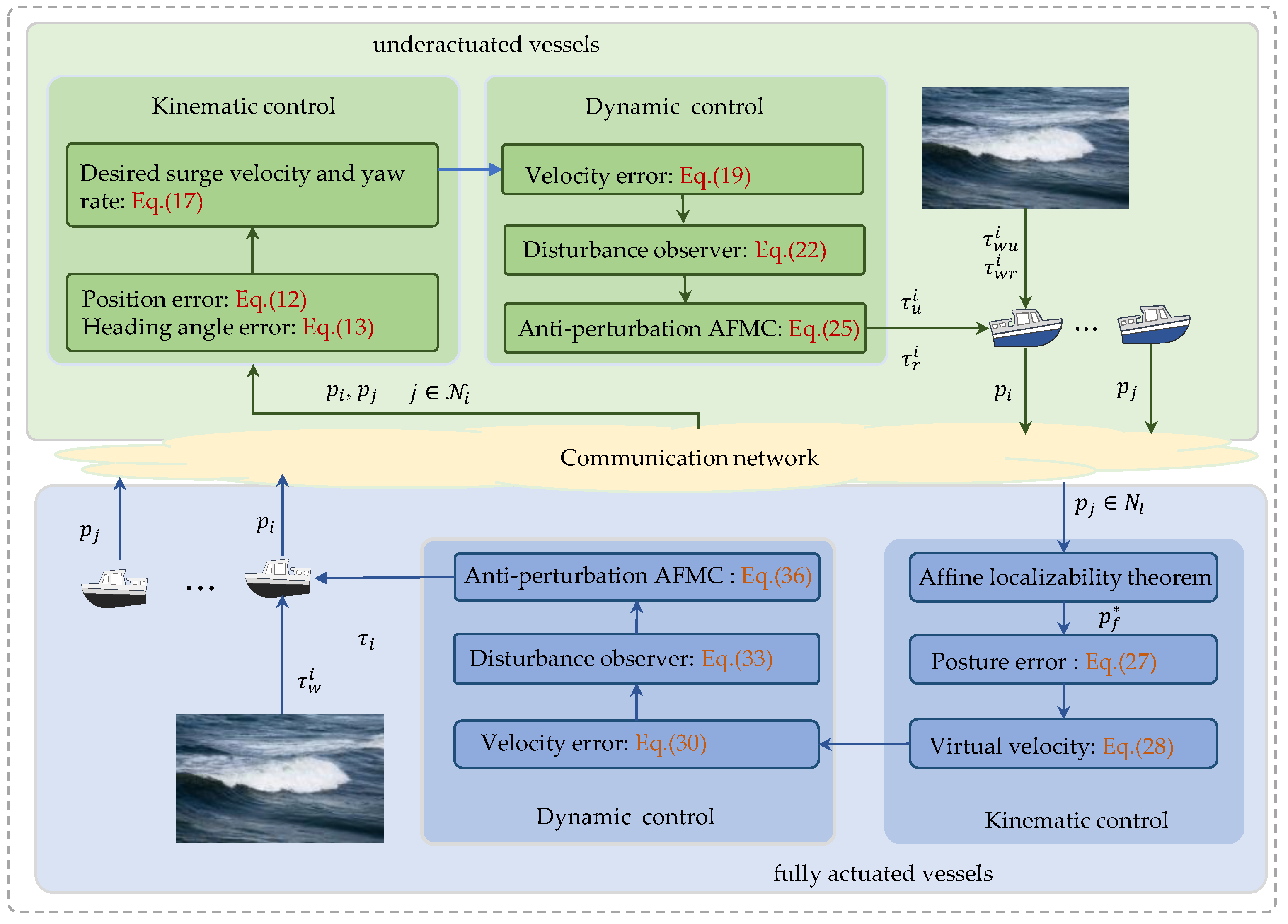

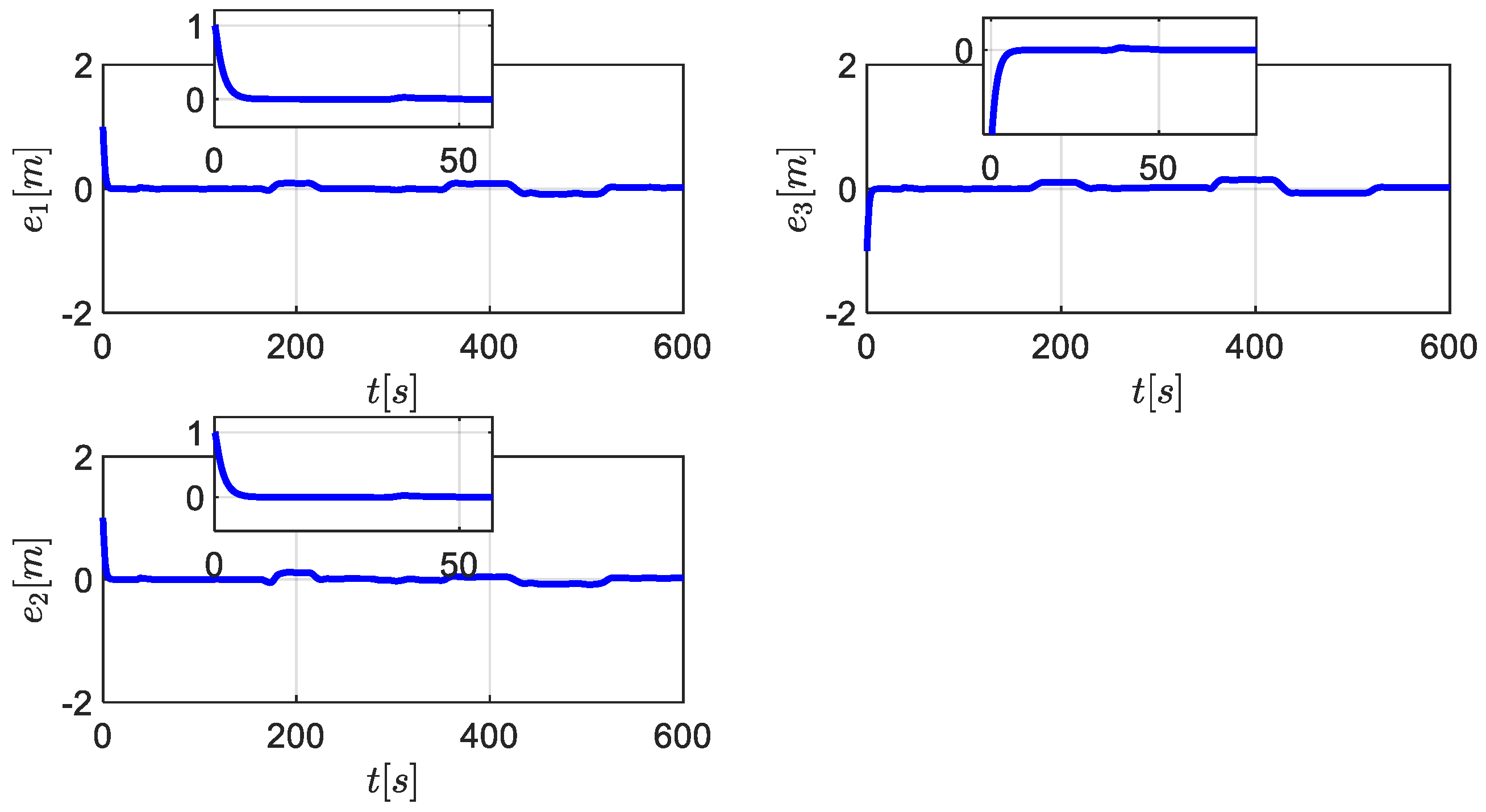
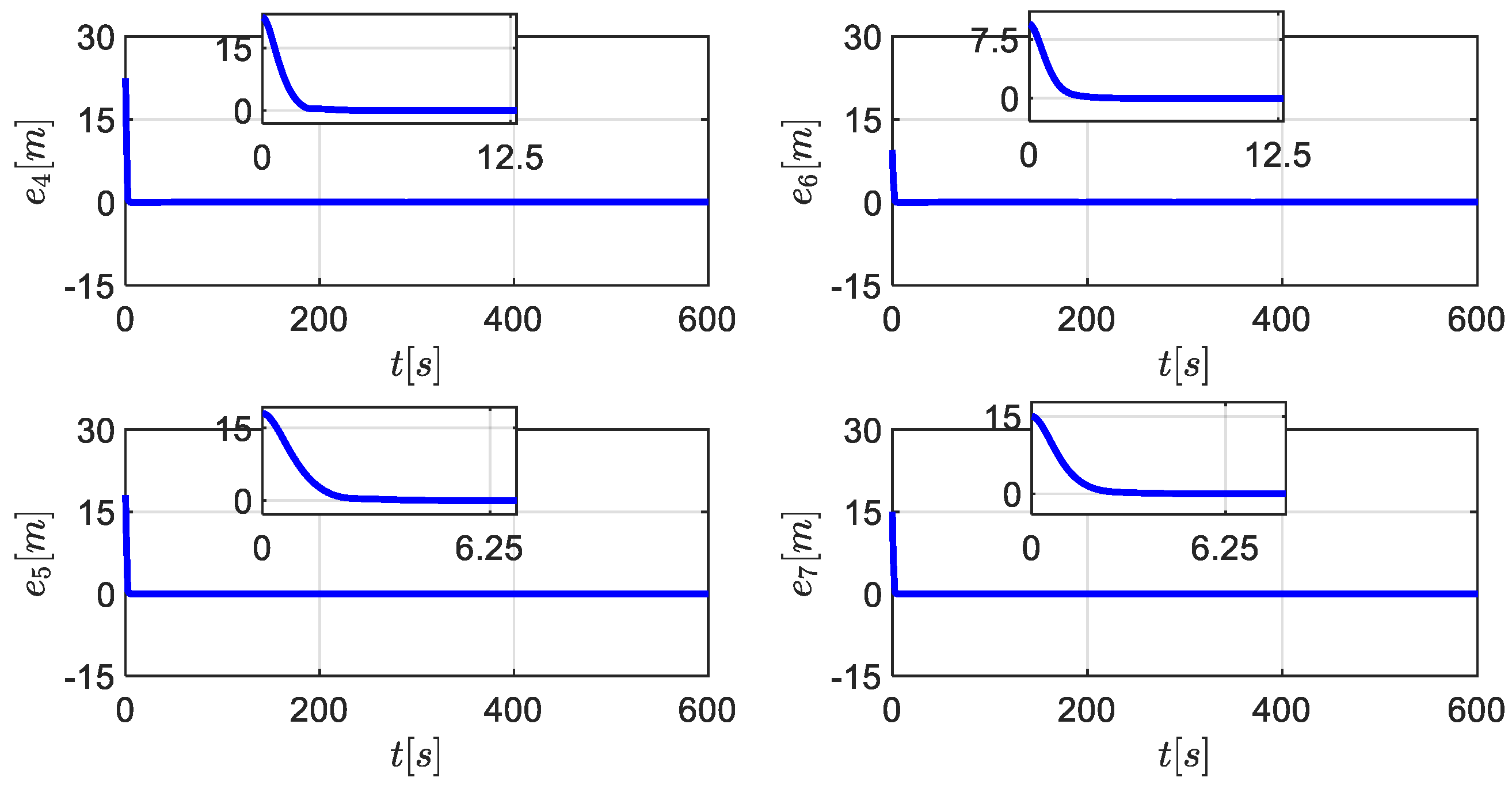
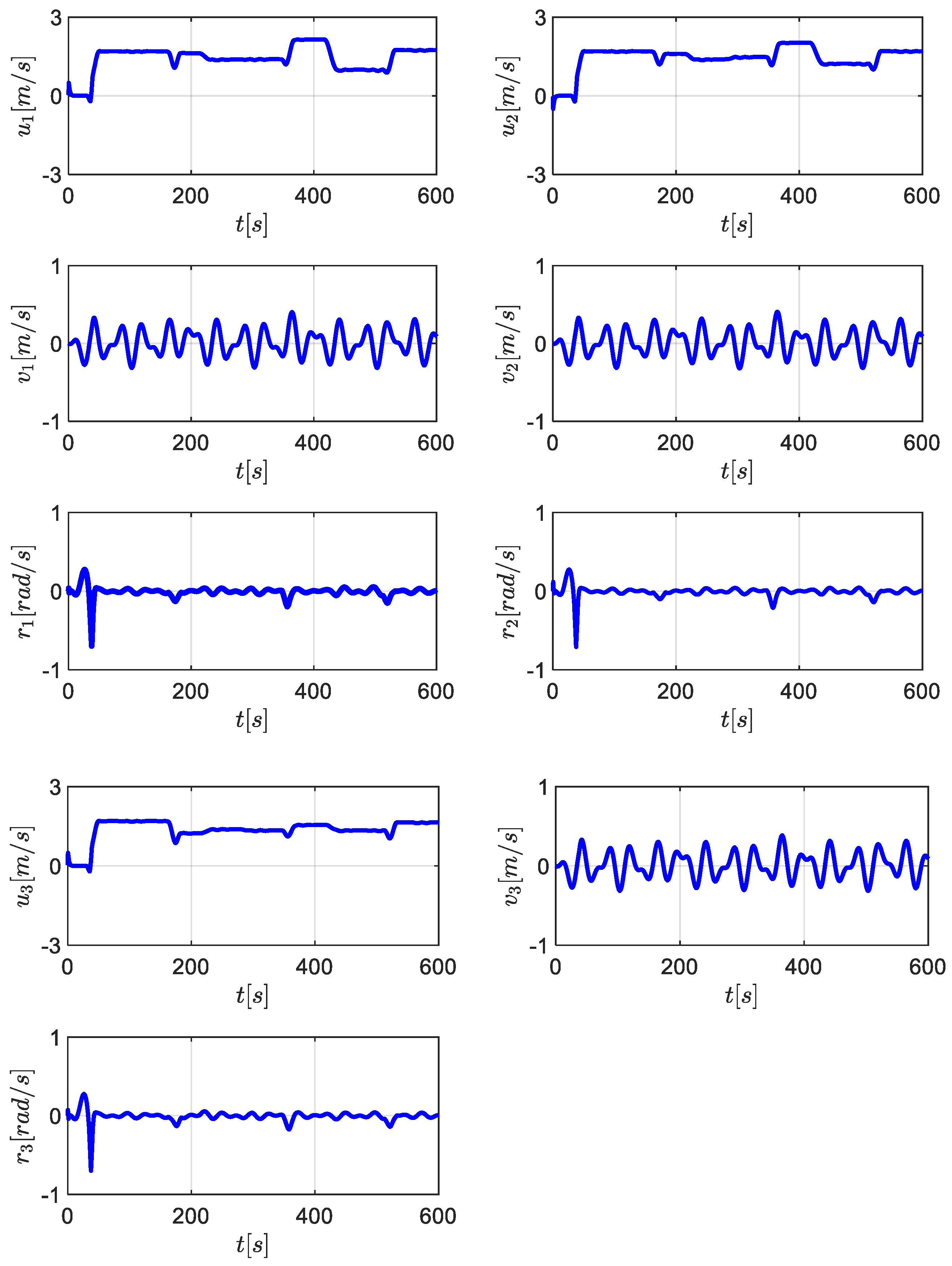
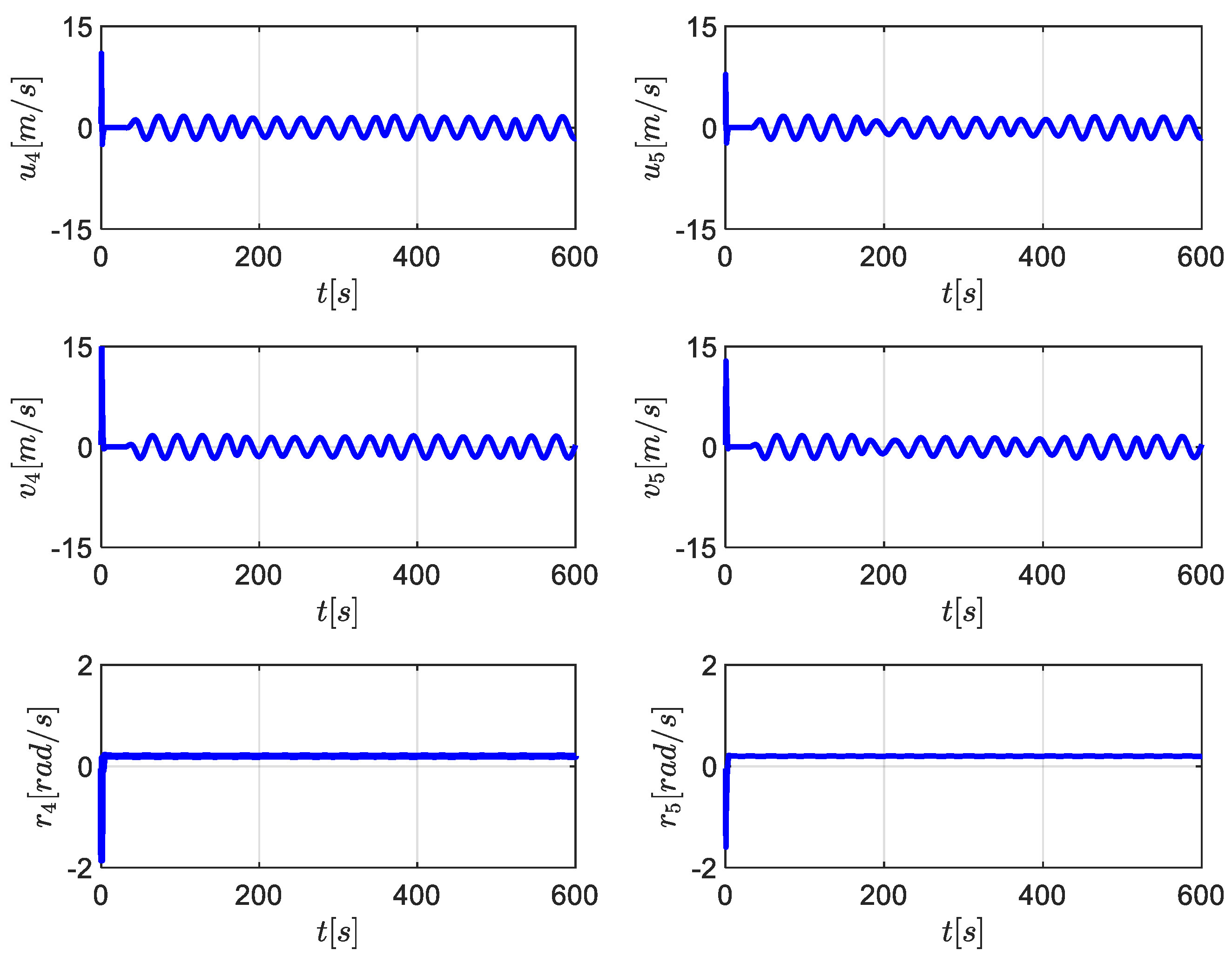
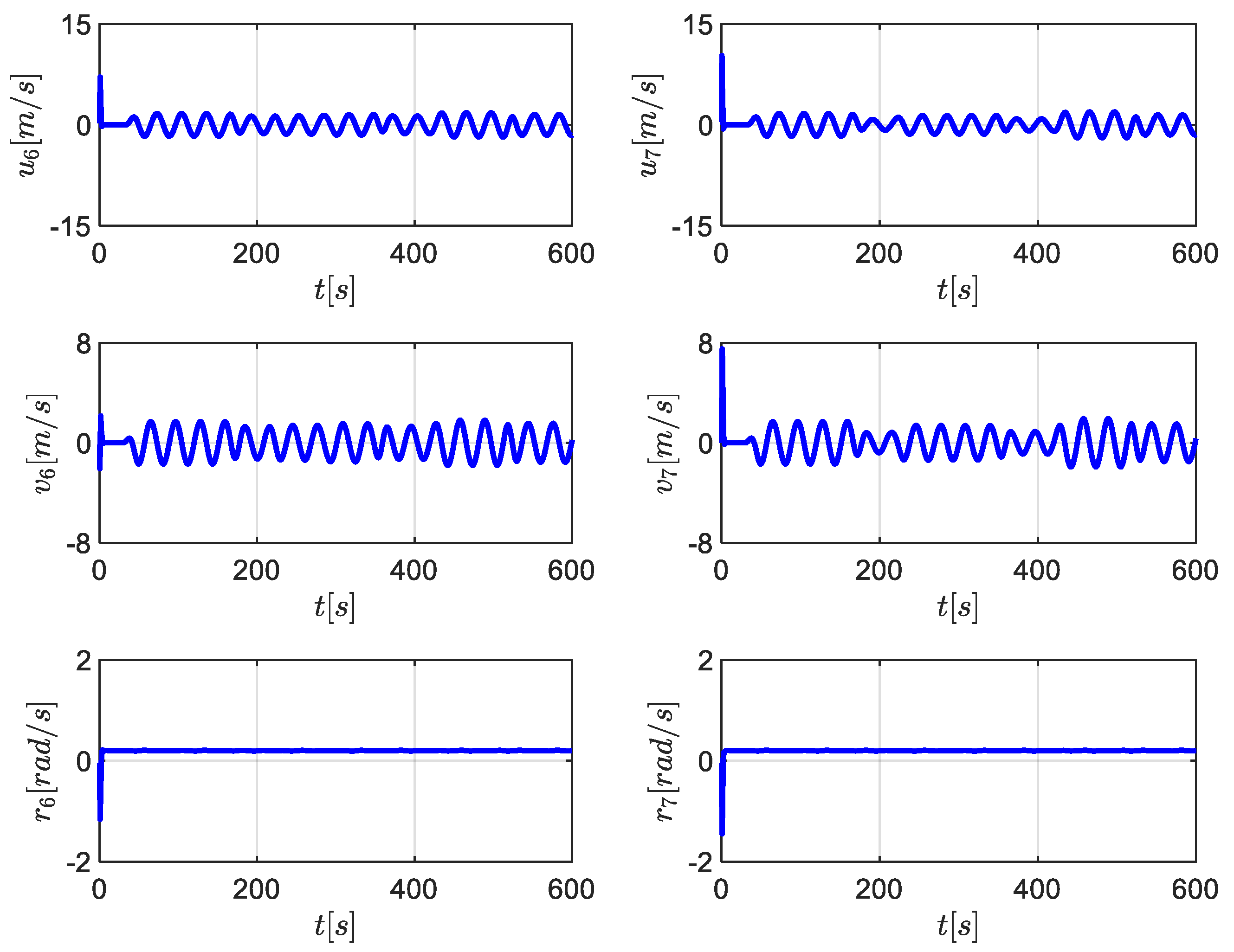
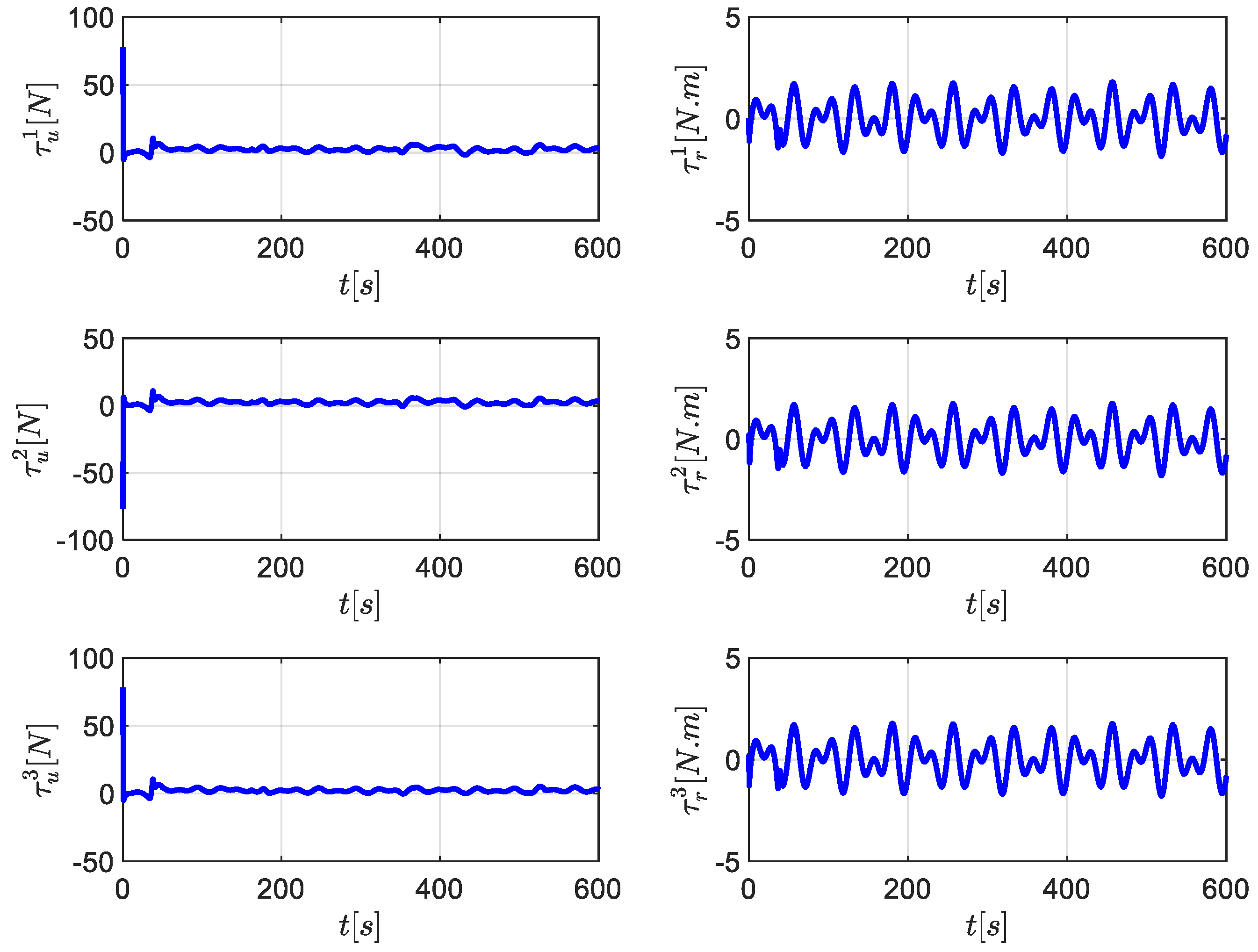
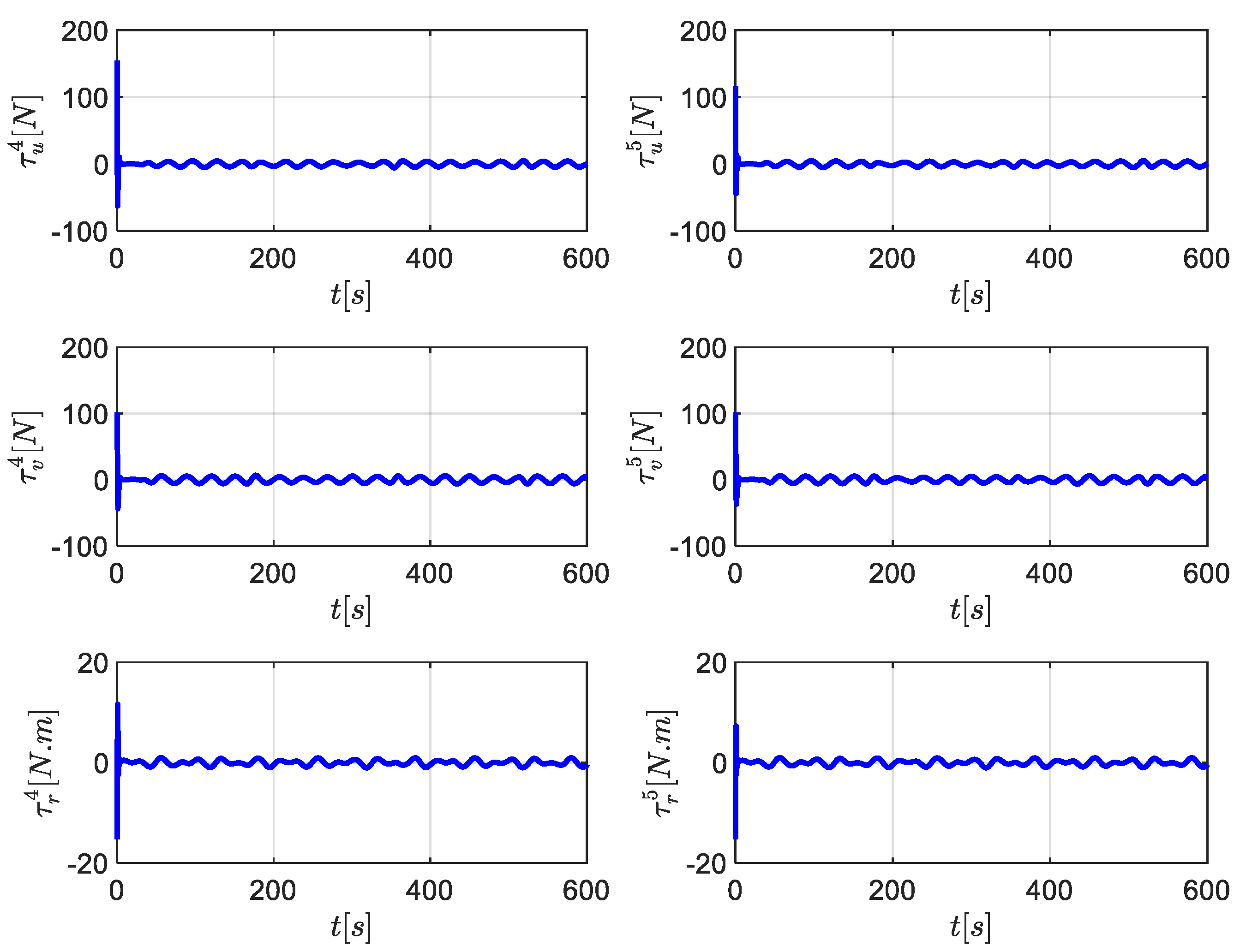
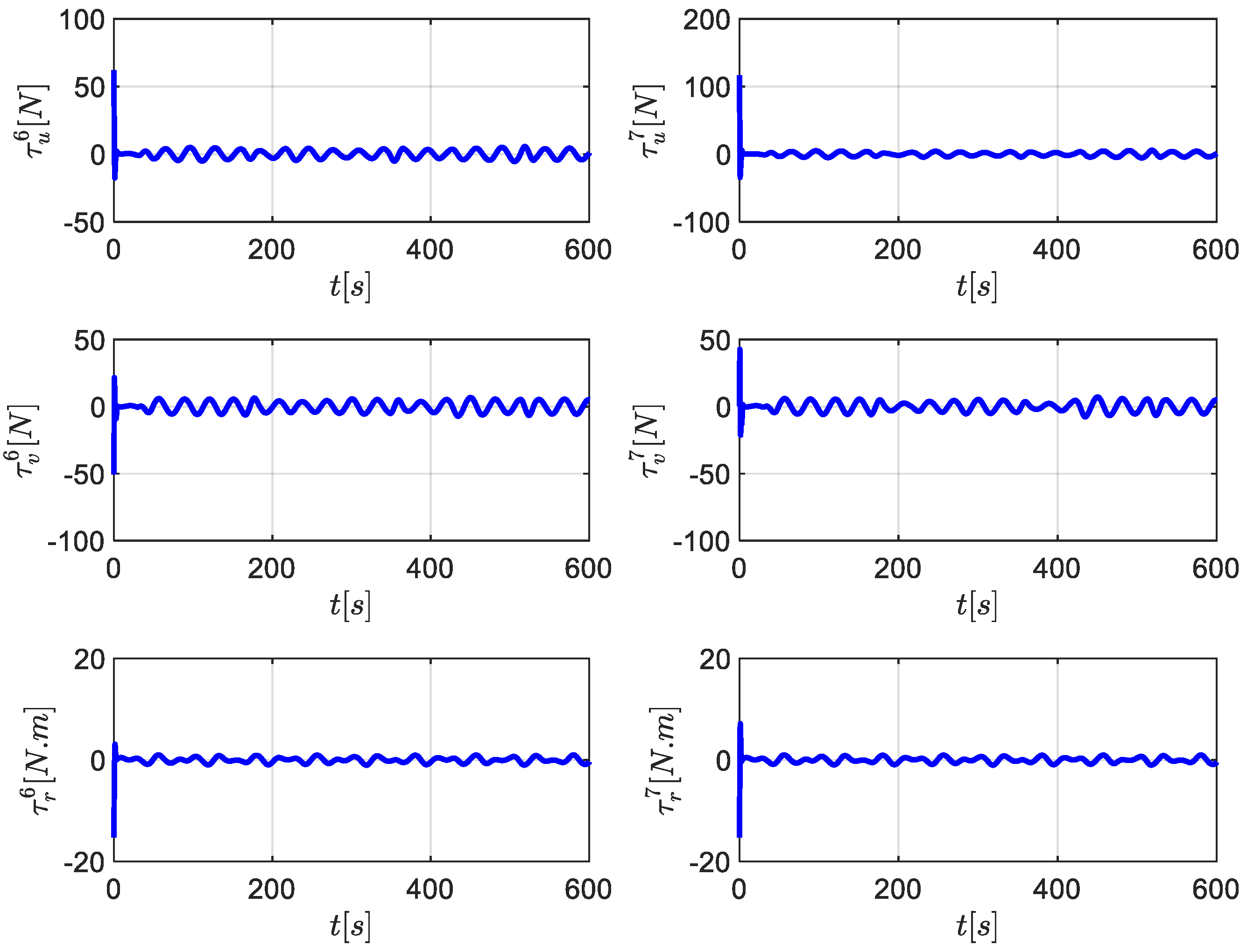
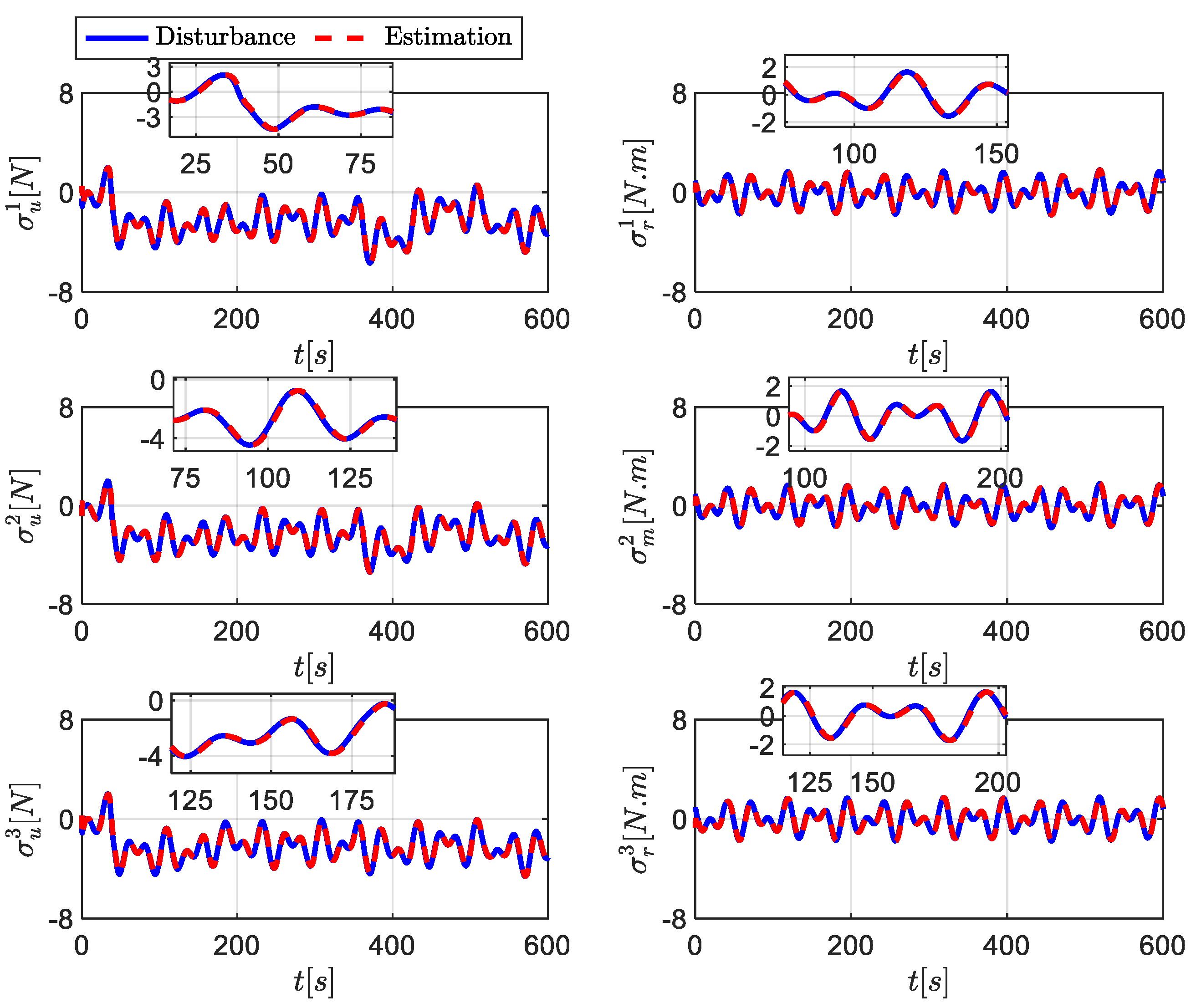
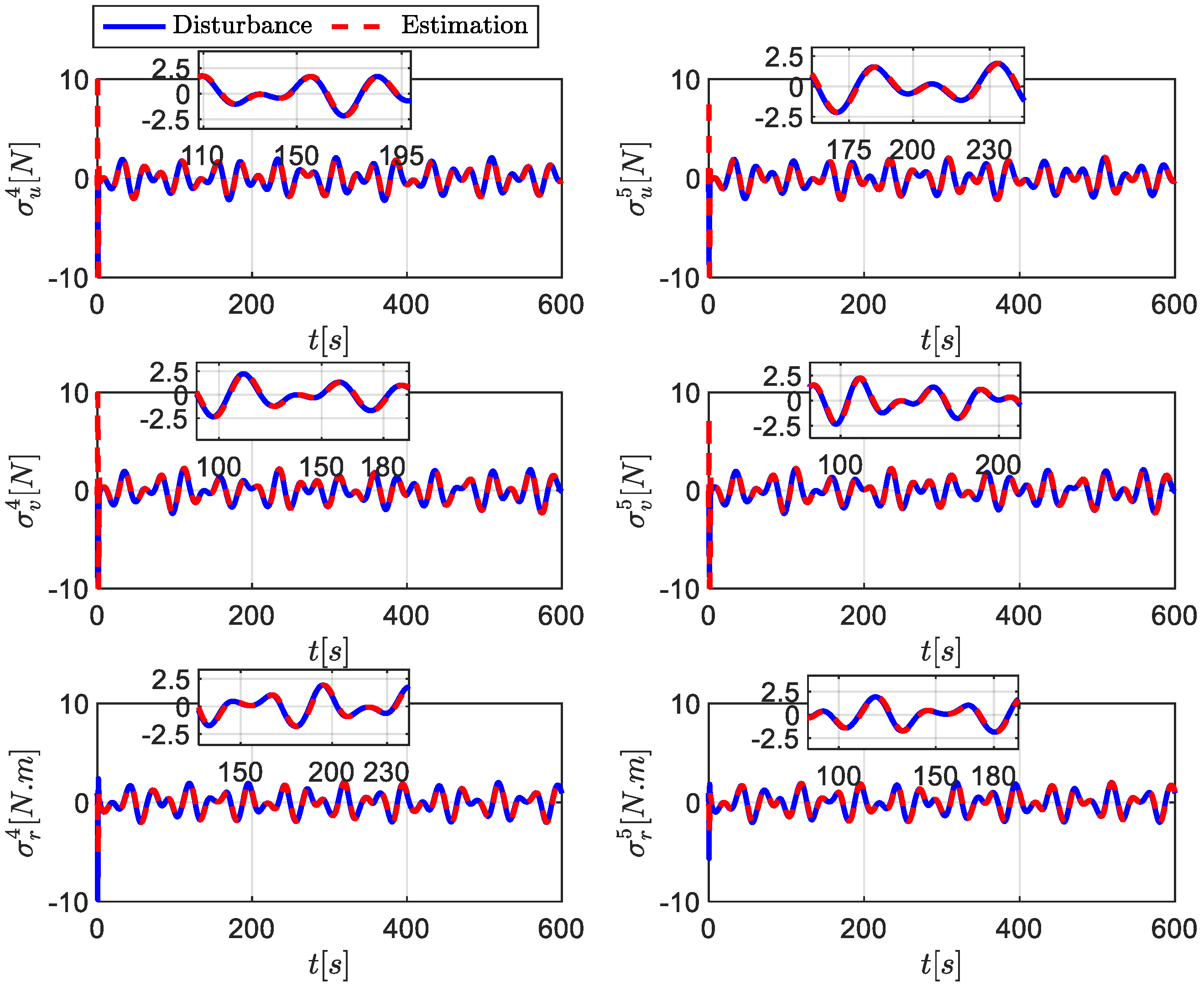

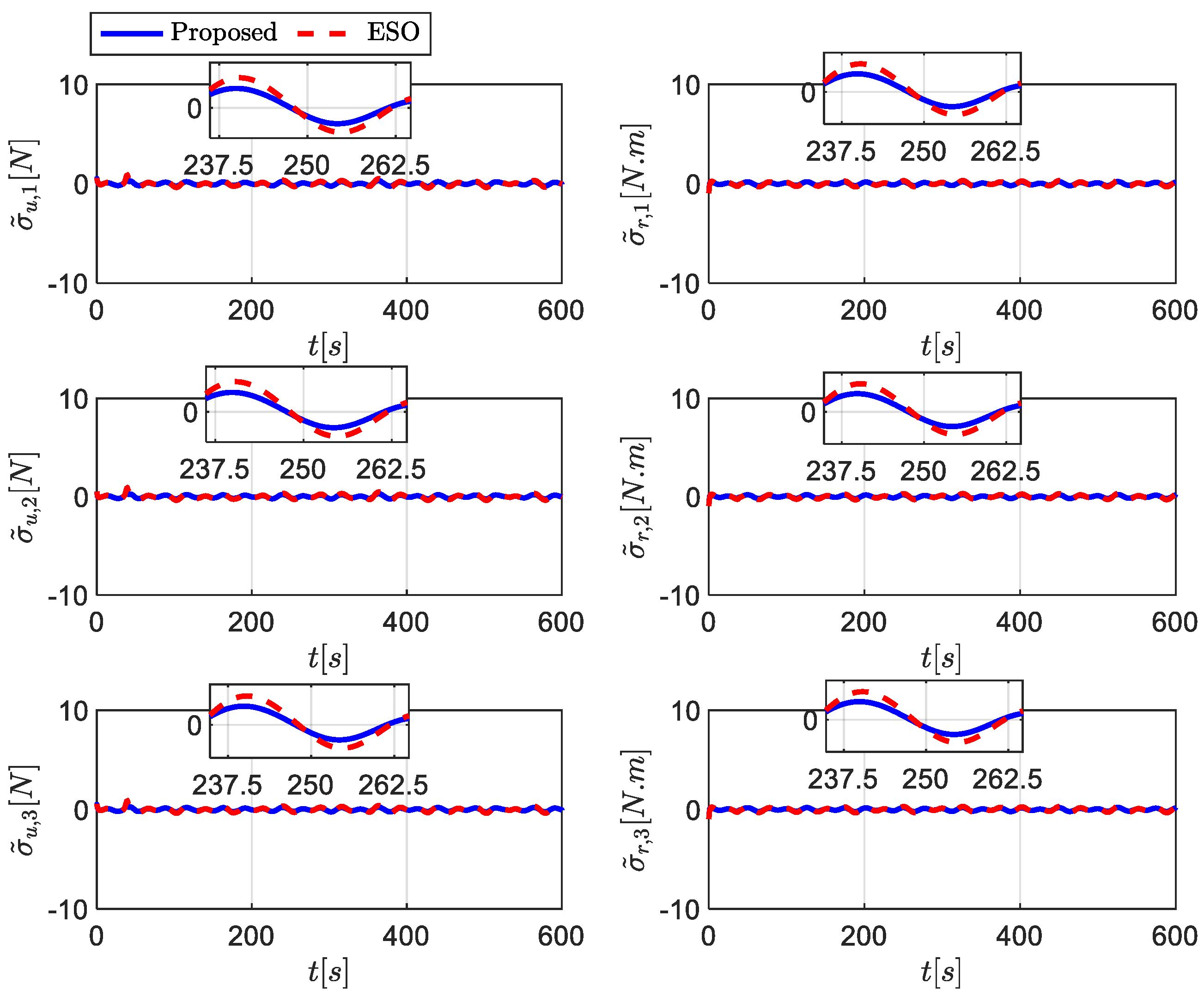
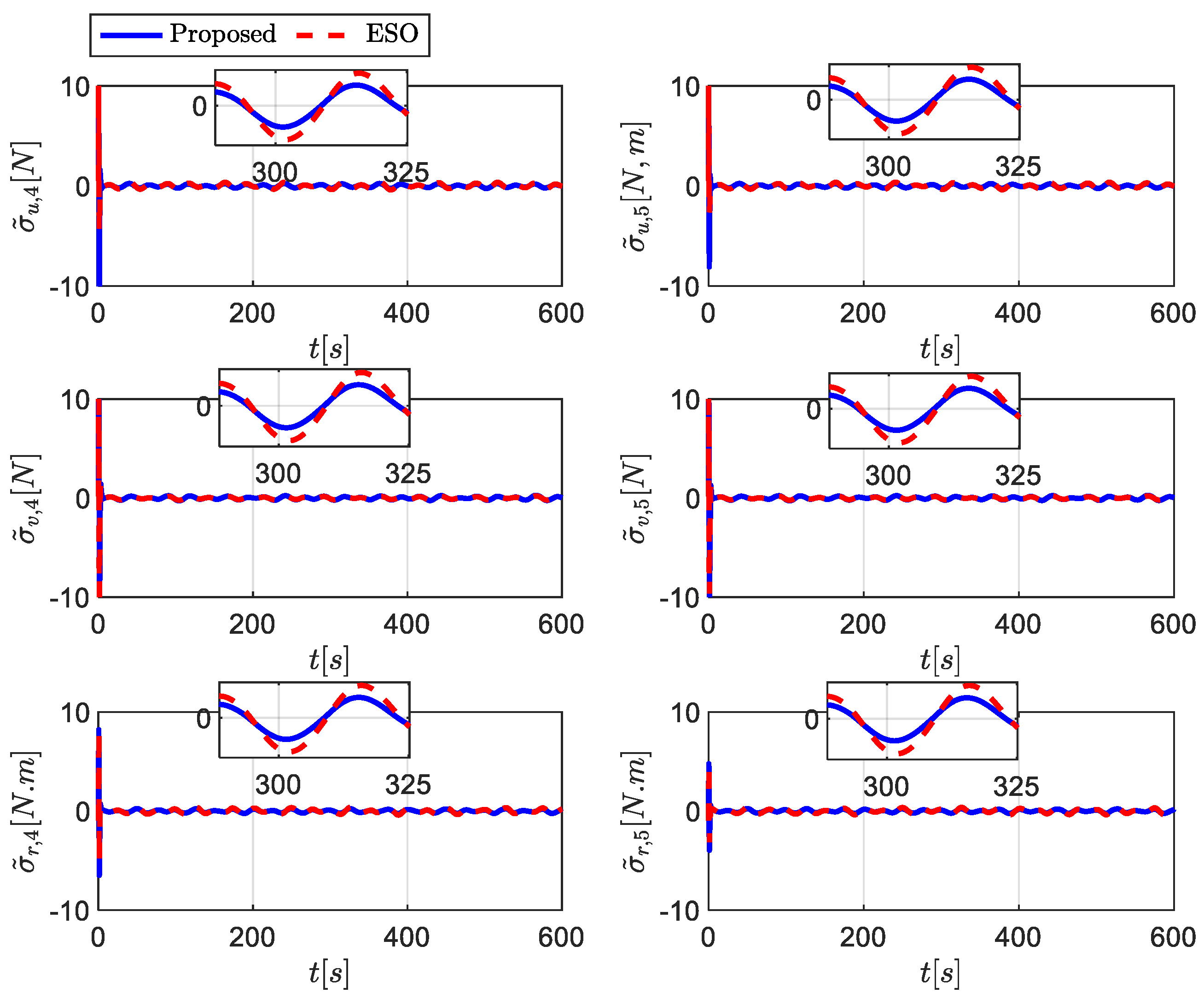
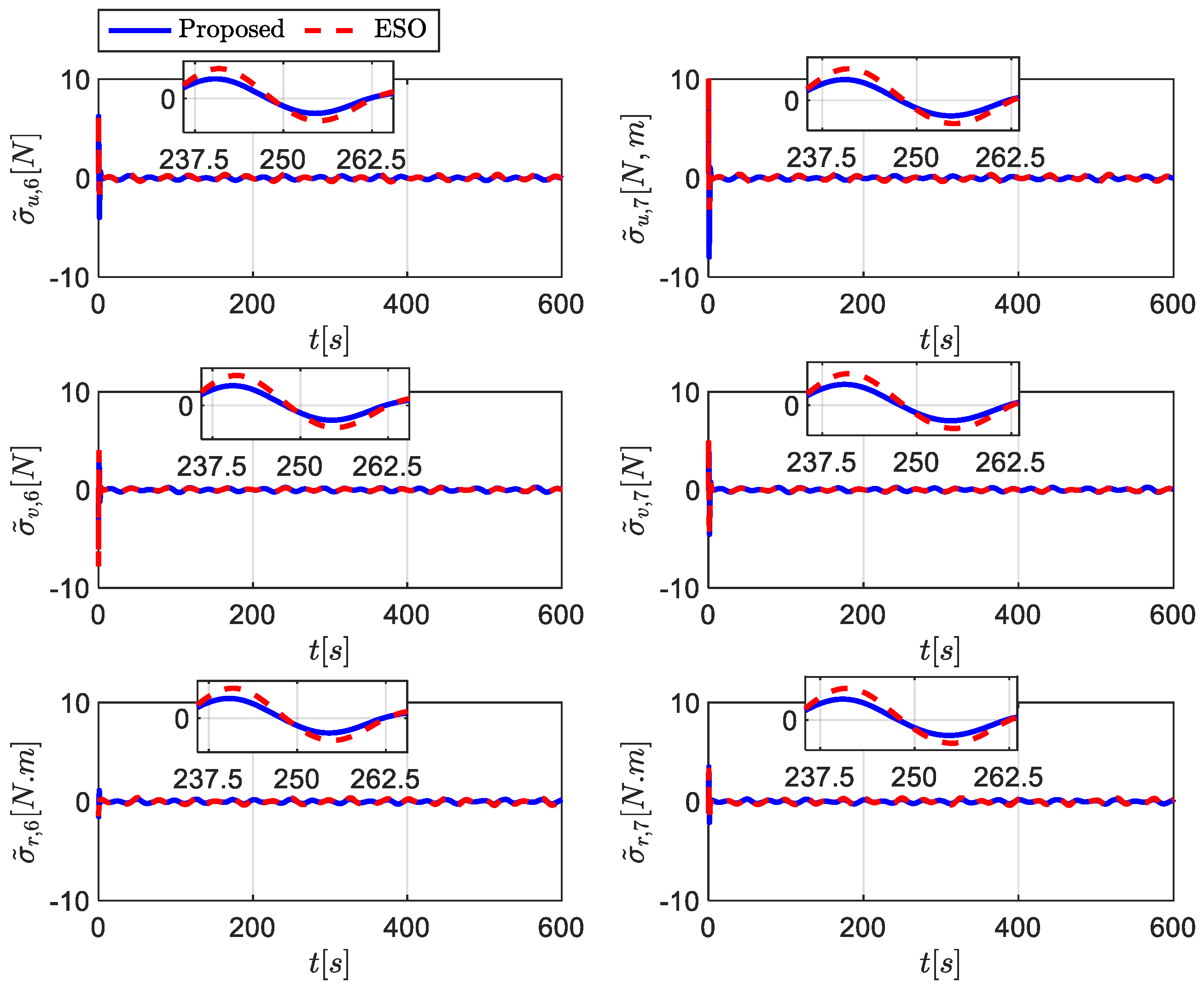
| Entry | Value | Entry | Value |
|---|---|---|---|
Disclaimer/Publisher’s Note: The statements, opinions and data contained in all publications are solely those of the individual author(s) and contributor(s) and not of MDPI and/or the editor(s). MDPI and/or the editor(s) disclaim responsibility for any injury to people or property resulting from any ideas, methods, instructions or products referred to in the content. |
© 2023 by the authors. Licensee MDPI, Basel, Switzerland. This article is an open access article distributed under the terms and conditions of the Creative Commons Attribution (CC BY) license (https://creativecommons.org/licenses/by/4.0/).
Share and Cite
Liu, Y.; Lin, X.; Zhang, C. Affine Formation Maneuver Control for Multi-Heterogeneous Unmanned Surface Vessels in Narrow Channel Environments. J. Mar. Sci. Eng. 2023, 11, 1811. https://doi.org/10.3390/jmse11091811
Liu Y, Lin X, Zhang C. Affine Formation Maneuver Control for Multi-Heterogeneous Unmanned Surface Vessels in Narrow Channel Environments. Journal of Marine Science and Engineering. 2023; 11(9):1811. https://doi.org/10.3390/jmse11091811
Chicago/Turabian StyleLiu, Yeye, Xiaogong Lin, and Chao Zhang. 2023. "Affine Formation Maneuver Control for Multi-Heterogeneous Unmanned Surface Vessels in Narrow Channel Environments" Journal of Marine Science and Engineering 11, no. 9: 1811. https://doi.org/10.3390/jmse11091811
APA StyleLiu, Y., Lin, X., & Zhang, C. (2023). Affine Formation Maneuver Control for Multi-Heterogeneous Unmanned Surface Vessels in Narrow Channel Environments. Journal of Marine Science and Engineering, 11(9), 1811. https://doi.org/10.3390/jmse11091811





